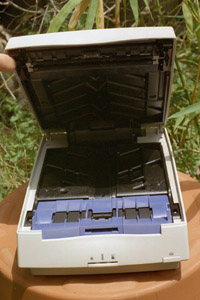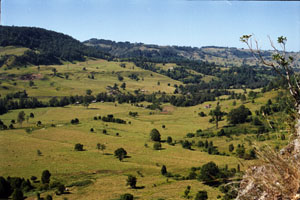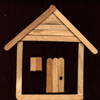|
Eddie's HP-Photosmart page.
Obsolete
Page,
I now use a
canoscan FS2710.
(See my photo gallery
for more images scanned with photosmart, they are 800*600 high
quality Jpegs.)
A few weeks ago (august 98), I became the part owner of a HP
Photosmart scanner. This was after much agonizing over what to
buy. Our primary requirement was for a slide and negative scanner
suitable for archiving our photo collections and making web pages
etc. The photosmart was one of around five scanners on our short
list, none of the others scanned prints.
The HP photosmart scanner is able to scan up to 7*5 inch prints
and 35mm mounted slides and filmstrips. The price is around AU$800
(RRP AU$940). The scanner is a moving film/paper type and not to
be confused with flatbeds with transperancy adaptors. The
photosmart was in our price range, it had good resolution and
mostly good reviews. Surfing the web exposed two re-occuring
complaints.
These are :-
Others expressed concern about the film being rolled through
without any protective carrier. I read about a third party batch
mode scanning program called Vuesmart - having an alternative to
the HP software helped sway us towards the Photosmart.
We bought our scanner from on special from interstate - the
scanner had a faulty media-type switch and was replaced. That was
bad news number one. Number two was that it took nearly 30 minutes
to scan one slide at 2400 DPI plus write it out to disk from
Photoshop :-( Number three was the noise problem showed up in the
very first slide scan :-( :-(
My PC (P90) is not up to the task of scanning beyond 1200
DPI as it only has 24 meg of ram fitted, I expect a huge
improvement when I upgrade to 64 meg. (Later - my P300 with 64 meg
RAM did improved things somewhat)
The scanner was sold bundled with a SCSI card and microsoft
"picture it" software.
The good news is that, from negatives and prints, the
resolution and color balance are much better than the scans from
my cheap flatbed scanner. For small compressed images there isn't
much difference but for anything over say 200*300 you can notice
the improvement.
 The
is a 300*200 reduction from a 2400 DPI scan. It was scanned from a
kodak-gold (100 ISO) colour negative. Click either image for a
900*600 version of the same photo. Even the 900*600 pixel image
(241K) looses much of the detail which is in the un-compressed
3368*2240 scan. The
is a 300*200 reduction from a 2400 DPI scan. It was scanned from a
kodak-gold (100 ISO) colour negative. Click either image for a
900*600 version of the same photo. Even the 900*600 pixel image
(241K) looses much of the detail which is in the un-compressed
3368*2240 scan.
 This
is a 200*200 pixel portion of the full resolution scan. You can be
forgiven for not even seeing this house in the above image. This
is a 200*200 pixel portion of the full resolution scan. You can be
forgiven for not even seeing this house in the above image.
|
So what do I think of HP driver?
Well I've
seen worse but it could be better.
The Bad.....
The software seems to be aimed at the "scan
and print" users rather than those who just want image files. It
took a while to confirm that it was re-sizing my scans by default and
almost as long to figure out how to stop it. I would have expected
this in the tools/resolution section but no it was cropping section.
I haven't found a control for Jpeg quality. Is it in there somewhere?
The ejection of the negative strips after every scan is plain
silly but I actually find the number of mouse clicks and key strokes
to save each file is more annoying. All that's needed to fix this is
one button that saves the image using a series of automatically
generated names. (eg image001.jpg, image002.jpg etc). Leave the long
winded option there for those who want it but many of us will use
thumbnails to sort files not filenames. Give to programmers 10 rolls
of film each to scan before they go home and they'll think of easier
ways to do things :-)
There's no way I could see to keep the exposure and colour
settings from one scan to the next - so even when you're scanning a
series of photos that all have the same exposure and balance you have
to correct each one as you go. When I scanned 50 Kodachrome slides
each one needed roughtly the same amount of red added - this gets
quite annoying. Most of my negative scans seems to have a cyan/red
cross over in them - highlights are cyan shadows are red. Again this
could be fixed in software.
What do I think of the noise problem?
Well
obviously it sux but you have to bear in mind this is a budget
scanner and you get what you pay for. Unlike the software issue -
fixing the hardware could be expensive (or not depending on what the
problem is). The noise is not random (thermal) noise, it's being
picked up from somewhere - most likely it's from the PC. Some
speculate that the problem is from noise being transmitted down the
SCSI cable (or radiated from it?). Some ferrite around the cable will
be worth a try, or shielding the PC and scanner? Note that this is
only a problem with scans from some slides, prints and negs scans
are fine. I tried reproducing the noise problem the other night and
couldn't - I don't know what changed but it scanned the same
images with the fringes? (weeks later) - I have seen artifacts
in negative scans - usually in light gray skies. I now strongly
suspect power supply noise as a contributing factor but I don't think
it power supply noise alone.
What about the roller mechanism?
It seems
fine. Unless the film miss-tracks (which doesn't seem to do) the
image area of the 35mm film strips does not touch anything, it's only
driven by the edges. I've re-scanned the same negative maybe 20 times
during testing without damaging it. Once you get the knack of
inserting the strip - it's easy.
About VueSmart.
VueSmart is a free program for registered users of VuePrint (15
day trial shareware - $40 to register, US $ I presume). It is written
by Ed Hamrick. see VuePrint
- Technical
VueSmart is a totally different kettle of fish to
the bundled driver. Vuesmart is a batch scanner. The user has dozens
of options to play with but once the scanning starts the user just
feeds in the film - strip after strip. Vuesmart works by scanning a
whole strip of film in a single pass, saving it as a TIF file and
then processing this file into cropped images of either TIF and/or
JPEG format.
Vue-Smart version 3.0,
Each version has
seen significant improvements over the previous ones - both in terms
of its user interface and automatic color correction. About the time
I download version 3, I had the unpleasant experience of upgrading to
windows-98, this is an ordeal I still have not recovered from. Win-98
rendered VueSmart useless for a time. The symptoms of the problem
were windows giving me "out of disk space" errors (I had
about 1 gigbyte free in two partitions) and the images had lines
across them (across not along as you'd get from crud on the ccd).
VueSmart was the only program giving this error message but it was
probably the only program writing 33 megabyte files to disk. The
problem *appears* to have been caused by Norton Utilities deletion
protection software. I have not had the problem since uninstalling
Nortons but you never can tell. I scanned one roll of film which was
hot out of the film processor and was not totally happy with the
results. I checked the film type an was surprised to find it was not
a "kodak gold 100 generation 6" as I'd assumed. I'm not
sure what it is, the colored strips would indicate it a generation 2
film but has the number 100-5 on it which I'd guess to mean
generation 5 - and there's no such animal in the options. I
re-scanned it as a generation 2 and changed the gamma from 2.2 to
1.8. The results were fairly good but I feel the generation 6 film
I'd scanned with VS version 2 was better. I'll update this page next
time I have a new gen-6 film to scan. (Don't hold your breath
waiting). I've posted a contact sheet of the
images for you to check out. Note the film covers a range of
conditions including some underexposed shots and very high contrast
lighting. Of the 37 photos there's only one which I think it got
wrong. This is frame 34 - a photo of a house and it's reflection in a
lake. This is mainly too light but could be corrected fairly well
without rescanning. I used six of these images for my web-site and
only made slight gamma corrections to five of them and gamma and
color corrections to frame 11. This is much less correcting than I
used to do using the HP software - I'd often correct during the
scanning and again before using them on the web. The actual scanning
is much less painful with VueSmart, I haven't timed it but I'd guess
it takes around a minute per frame on my cyrix-300 (running at 266
meg). If the negatives are dirty this gives just enough time for
cleaning each strip. As stated earlier VueSmart is a companion to
VuePrint - you have to have a registered copy of VuePrint installed
to disable the watermarking (I haven't seen the watermarks because I
was registered). I would have preferred it as a separate package but
it's the Eds prerogative to bundle it as he sees fit. I suspect
Version 3 will not the last release it will be interesting to see
where it's headed. I'd also like to note that I have no way to check
my monitor settings. What looks good on mine may look bad on yours.
If anybody knows of a test image for calibrating monitors please drop
me a line.
Will batch scanning work?
Well yes and no.
I don't think anyone can write a program to match a human in fine
tuning the image. In my 5 years in the professional photo-finishing
industry there were many cases where experts in colour balancing had
different opinions on what a particular print should look like. There
is no rigid formula for what is good, different people have different
preferences - computers aren't good at that sort of thing.
So is automatic batch scanning is doomed?
If
you want every file to be perfect then yes it's doomed. However if
the aim it the scan a lots of film and get the images into the
digital domain as quickly as possible then it's the way to go. What
is required is a way to archive photos with a mimimum loss of
information, how it looks is not that important as long as the
information is there for further processing. I'd expect that image
compression of the raw scanner data would fit the bill - but in the
case of negatives few thumbnails program accept negative files. In 40
years time when your grand-children (or whoever) try to view your
photos - the concept of a negative may be pretty foreign and programs
to view them non-existent (hopefully windows will be long gone too).
I think saving them as positives is safer. How much information is
lost in balancing and gamma correcting I don't know, there could be
an improvement in compression ratios for corrected images - again I
don't know. I doubt there'd be a huge difference in the information
content between corrected and raw so we may as well correct them as
best we can. What compression? I think JPEG viewers will be around
for quite a while but the new lossless PGN format should be ideal
once it become more common. Of course the software doesn't know which
way is up so some images need to be rotated afterwards. It would be
neat to have a thumbnail and slide show program that could remember
the orientation in it's data base and show the images right way up
while leaving the original image files as is. The same could be done
with other corrections such as gamma, colour balance and cropping.

home
page
 The
is a 300*200 reduction from a 2400 DPI scan. It was scanned from a
kodak-gold (100 ISO) colour negative. Click either image for a
900*600 version of the same photo. Even the 900*600 pixel image
(241K) looses much of the detail which is in the un-compressed
3368*2240 scan.
The
is a 300*200 reduction from a 2400 DPI scan. It was scanned from a
kodak-gold (100 ISO) colour negative. Click either image for a
900*600 version of the same photo. Even the 900*600 pixel image
(241K) looses much of the detail which is in the un-compressed
3368*2240 scan. This
is a 200*200 pixel portion of the full resolution scan. You can be
forgiven for not even seeing this house in the above image.
This
is a 200*200 pixel portion of the full resolution scan. You can be
forgiven for not even seeing this house in the above image.